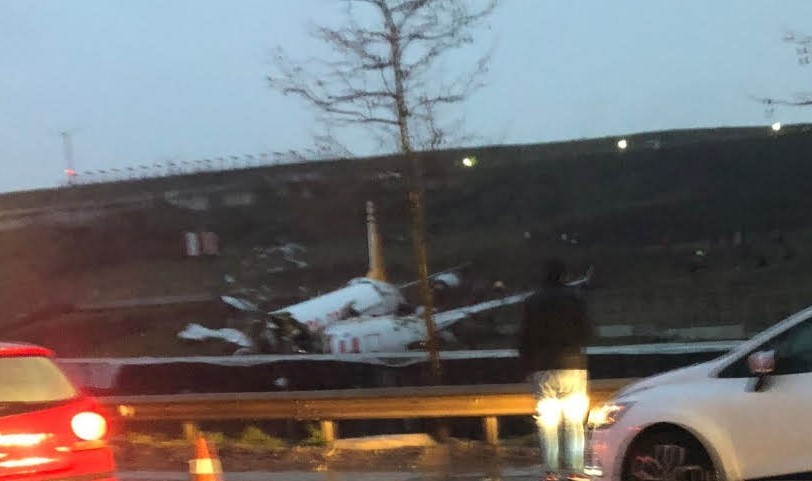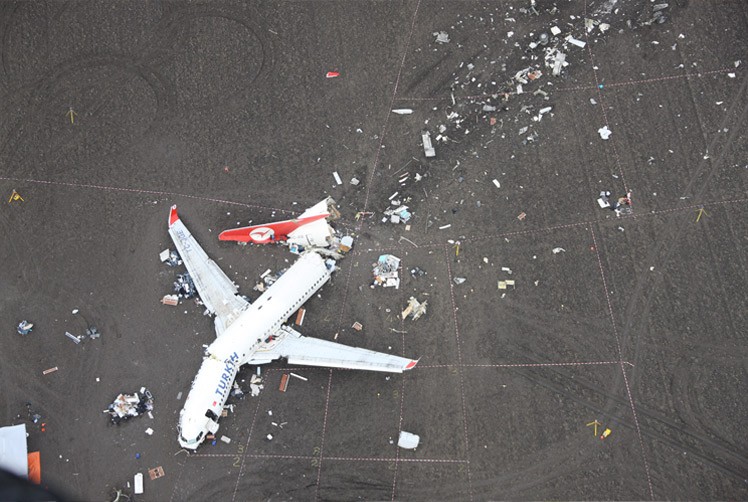 There’s something very worrisome about the wreckage photos of the Pegasus Airlines Boeing 737 that overran the runway at Istanbul’s Sabiha Gokcen Airport on February 5th, killing three and injuring nearly everyone else on board. Check out the photos below and see the eerie similarity to the way the fuselages fractured in almost exactly the same way in three previous runway excursion events involving Boeing 737 NG aircraft.
There’s something very worrisome about the wreckage photos of the Pegasus Airlines Boeing 737 that overran the runway at Istanbul’s Sabiha Gokcen Airport on February 5th, killing three and injuring nearly everyone else on board. Check out the photos below and see the eerie similarity to the way the fuselages fractured in almost exactly the same way in three previous runway excursion events involving Boeing 737 NG aircraft.

2009 Turkish Airlines Flight 1951 in Amsterdam – Radio Nederland Wereldomroep / Fred Vloo

2009 American Airlines Flight 331 in Kingston Jamaica Photo by Jatmf – Own work, CC BY-SA 4.0

2010 Aires Airlines Flight 8250 in Isla de San Andres, Colombia Photo courtesy Aeronautica Civil de Colombia
If you are wondering what this could mean about the model’s structural integrity and its ability to protect passengers in events like runway excursions, you are not alone. Concerns that substandard structural elements were installed on the 737 NG go back twenty years. That’s when employees of Boeing’s Wichita assembly plant first complained that parts produced for Boeing by California-based AHF Ducommun did not meet specifications.
The workers claimed the defective parts prevented Boeing’s newest iteration of the 737 from qualifying as airworthy under FAA regulations. In 2005 they filed a federal whistleblower suit against Boeing and Ducommon.
I urge you to follow the link at the end of the post to see the full one-hour documentary on the scandal produced by Al Jazeera. But spoiler alert, the Boeing workers did not prevail in their case.
In 2014, Monti Belot, the federal judge for the District of Kansas granted Boeing’s motion to dismiss the suit. Judge Monti wrote that if the FAA had determined there were flight safety issues with the 737 NG, “it would have been obligated to act.” Since it did not do so, there was nothing more the court could do with the evidence the employees had submitted.
The FAA “had the expertise to determine if aircraft parts conformed to design while Federal Judges and juries did not,” the judge ruled.
With all respect to Judge Belot, the list of Boeing safety issues the FAA has overlooked in the past is a lengthy one, (and the subject of an earlier blog post). The agency’s lapses usually get picked up after a disaster as the two 737 Max accidents which killed a total of 346 people in a six-month span surely illustrate.
In cases like the 737 NG runway overruns in 2009 and 2010, the investigations carried out by Colombia, Jamaica and the Netherlands, seem to have prioritized the accidents’ causal factors over the consequential ones. This left unaddressed the question of why the fuselages came apart.

“The fatalities didn’t occur because of the accident,” Michael Dreikorn said of the fatal accidents in Amsterdam and Colombia. “The people died because the airplane broke apart where it should not have.”
Dreikorn who has worked for the FAA, Pratt & Whitney and McDonnell Douglas and was an expert witness in the suit against Boeing hasn’t seen evidence that the structural deficiencies flagged by the whistleblowers are responsible for the signature breaks in the four 737 NG fuselages. “What we do have is hard evidence that the aircraft were not produced in accordance with the design requirements,” he said.
My contact in Istanbul, Turkish journalist Didem Kuzu reports that one of the three people killed in this month’s Pegasus accident was seated in the area where the plane split. But if the past is predictive, the Turkish air accident probe may once again fail to explore survivability in depth. When the Dutch released their report into the crash of Turkish Airlines Flight 1951 in Amsterdam which killed nine, it concluded there was much more to be done on the subject of survival factors and then suggested the Americans ought to look into it further.

Author of The New York Times bestseller, The Crash Detectives, I am also a journalist, public speaker and broadcaster specializing in aviation and travel.









The location of the fractures, just before and after the connection between wing and fuselage, is inherent to the weakest point of an airplane. Or put otherwise, the wing-fuselage connection is the main structure of an airplane. Construction is always a tradeoff between weight and strength. Every plane that crashes shows (main) cracks around the strongest point.
Just like every chain has a weakest link.
Did the B737 jets that are subject to the pickle fork AD concerning the cracks and fatigue of the fuselage to wing attachment have fuselage frames and straps built by Ducommon in the 1994-2002 timeframe???
@ Bert Neut:
Nothing you bring up in your comment contradicts the claim that there’s a problem with the structure and strenght of the 737 NG fuselage. The testimonies of many whistleblowers on the other hand indicate that because of some shortcuts taken in production, the fuselage of the 737 NG in many cases isn’t as strong as it would be if the plane had been produced in full accordance with the original design and acceptable production practices. There’s always the weakest point (or actually many of them) in all planes, but it doesn’t mean that those points can’t be made too weak.
The FAA doesn’t examine every part nor do they completely examine an aircraft being assembled as many processes are ODA. Sadly there is no way to enforce Boeing quality assurance of its vendors and anyone who speaks up is targeted, harassed, threatened, given corrective actions and eventually terminated.
Boeing runs on cost, schedule and shareholder value over quality and safety.
I have multiple investigations and have been run around and lied to as they claim it’s in legals hands. A year ago Boeing’s own investigator claimed he’d be getting back with me what a joke. I think its time to find a news agency.
Today, a 737-800 NG had a possible structural failure in mid-air in China. If this is related to what the whistleblowers are saying, thousands of lives are at stake.